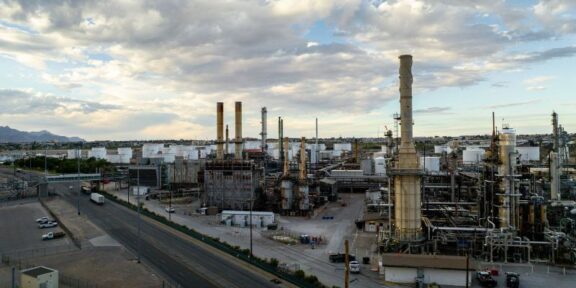Editor’s Be aware: Join CNN’s In the meantime in China e-newsletter, which explores what you have to know concerning the nation’s rise and the way it impacts the world.
Hong Kong
CNN
—
As temperatures soared throughout components of central China’s agricultural heartland final month, farmers struggled with day after day with out rain.
In sweltering Henan province, many scrambled to irrigate parched crops throughout what’s often a key rising interval, whereas authorities ordered water use to be restricted and for clouds to be artificially seeded in an effort to prod rain clouds, state media studies mentioned.
Only one month later, nevertheless, components of the province had been awash – pounded by excessive rain that inundated tens of 1000’s of acres of cropland and compelled greater than 100,000 folks to evacuate their properties, in line with state media.
Elements of Henan’s hardest-hit Nanyang metropolis noticed greater than 600 millimeters (about 24 inches) of rain in 24 hours – three-quarters of what they’d usually anticipate in a complete 12 months. Rescuers navigated streets on speedboats, at instances wading via waist-deep floodwaters to pluck folks from their properties, footage circulating on-line confirmed.
It’s a narrative enjoying out throughout China. Up to now two weeks, tens of 1000’s have been evacuated throughout a number of provinces within the nation following lethal floods and landslides, which have blocked highways, destroyed properties and brought about devastating monetary losses as they worn out crops and livestock.

The lurch from dry climate to flooding additionally throws into sharp focus the key problem for the Chinese language authorities as emergency response and restoration turns into an everyday incidence – and as excessive climate is simply anticipated to develop into extra frequent as a result of human-driven local weather change.
The flooding in Henan and surrounding provinces final week – and the double hit of arid warmth and floods in a matter of weeks – has extended what has already been a devastating interval of maximum climate throughout China that’s forecast to proceed.
Torrential rainfall has hit southern, central and jap components of the nation and led to main emergency response efforts in a flood season that has began some two months forward of its typical schedule and solely final week entered what’s often known as its peak interval.
China’s ruling Communist Occasion acknowledged the urgency of the scenario final week, when a communique following a landmark assembly of its prime members led by Chinese language chief Xi Jinping pledged to “refine the measures for monitoring, stopping, and controlling pure disasters, particularly floods.”
The federal government has lately grown more and more alert to the home threat of local weather change – together with its potential affect on meals safety as drought and floods hit lands vital for the nationwide grain provide.

China, the world’s largest greenhouse fuel emitter, has appeared to place itself as a frontrunner within the world transition to inexperienced power – even because it’s met challenges weaning itself off coal as a result of excessive demand for energy.
Authorities are in the meantime grappling with the most recent crises amid mounting social frustration with China’s stuttering economic system and the broader path of the nation – and as native governments strapped with excessive ranges of debt are tasked with restoration efforts.
Earlier than final week’s floods, pure disasters had already value practically $13 billion in direct financial losses and affected 32 million folks this 12 months, China’s Ministry of Emergency Administration mentioned on July 12.
“Final evening I couldn’t sleep in any respect,” one farmer in Henan’s Nanyang metropolis mentioned as he surveyed submerged crop fields in a video posted to social media and shared by a government-linked account.
“All my arduous work for a 12 months has come to nothing.”

Because the heavy rains moved throughout central China in latest days, accounts of loss and devastated livelihoods additionally unfold throughout social and native media.
At the very least 34 folks have been killed since final weekend as a result of flooding and landslides, together with 15 who died in a bridge collapse in Shaanxi province Friday following flash floods and heavy rain. It comes after flooding and landslides late final month killed a minimum of 71 folks in southern China.
One video posted on social media confirmed a farmer in Sichuan province wading via chest-high waters to select corn – clearly decided to not lose his harvest.
In the meantime, a farmer in flood-hit Hunan misplaced greater than 800 pigs – taking a success of about $275,000 – after his barn was inundated this month, he informed state-backed Agricultural Tv.
Retailers and farmers have additionally taken to social media to promote flooded crops at a reduction – for a lot of a last-ditch try and salvage an earnings in a rustic the place analysis exhibits insurance coverage protection is low in contrast with different main economies.
As of Sunday, 10 provinces had been below emergency alerts for flooding, in line with nationwide climate authorities, with extra heavy rain anticipated within the coming days.
A hurricane that hit China’s Hainan island Monday is predicted to make landfall on the mainland as a tropical storm Tuesday, whereas a cyclone that would strengthen to a hurricane is predicted to hit coastal China later this week, in line with CNN Climate.
China’s authorities has mounted a top-down effort to revamp how the nation responds to excessive climate lately after 2021 floods in Henan’s Zhengzhou killed greater than 300 folks. And local weather scientists earlier this month issued a stark warning, calling the nation a “hotspot the place the impacts of local weather change are acutely felt.”
Observers say authorities have made progress, particularly in the case of early warnings and response, climate monitoring and sure infrastructure improvement – however additionally they observe extra have to be finished in China – like many nations grappling with local weather change – to organize for the affect of extra frequent excessive climate.
“Whereas insurance policies and methods are being developed and applied, the tempo and scale of motion typically fall quick of what’s wanted to successfully mitigate the dangers and impacts of local weather change,” mentioned Hongzhang Xu, an adjunct analysis fellow on the Australian Nationwide College.
That want could also be extra acute in distant, rural or mountainous areas, typically populated by weak aged populations and with fewer sources, in addition to provinces not traditionally vulnerable to extreme flooding, like in China’s northeastern breadbasket, which endured excessive rains final 12 months.
One other problem, consultants say, is bolstering restoration from extreme flooding, the place broken croplands, destroyed properties and devastated livelihoods can take months to get well.

Native governments are sometimes tasked with managing reconstruction efforts, whereas the central authorities performs a task in planning and financing. However there have been previous problems with misappropriation of state restoration funds, for instance following the lethal 2021 floods in Zhengzhou.
And solely about 8% of an mixture $25 billion in losses in China from flooding attributable to Storm Doksuri final summer time had been coated by insurance coverage, in line with information from world insurance coverage agency Munich Re.
“Farmlands have to be re-plowed, and absolutely restoring soil high quality would take a number of months,” mentioned Li Zhao, a senior researcher at Greenpeace East Asia in Beijing. “For the residential homes, every family ought to spend some huge cash to rebuild – simply to get well from this type of occasion could be very troublesome.”
These residing in flood-prone areas additionally face a tricky selection because the dangers develop, she added.
“Possibly sooner or later, we’ll see how folks make the choice,” she mentioned. “Are they transferring to a safer place? Or will they return to the villages (and rebuild)?”
















